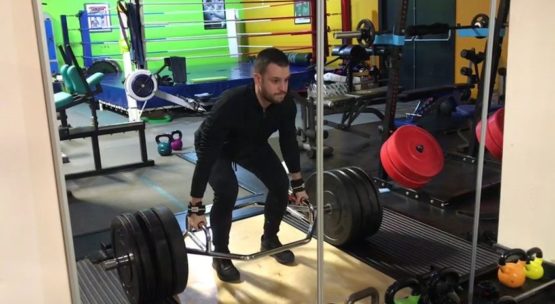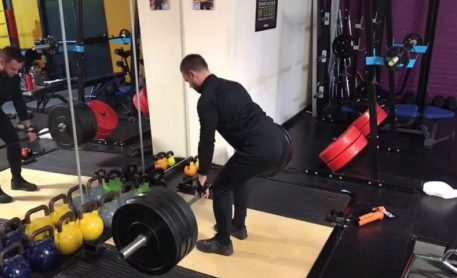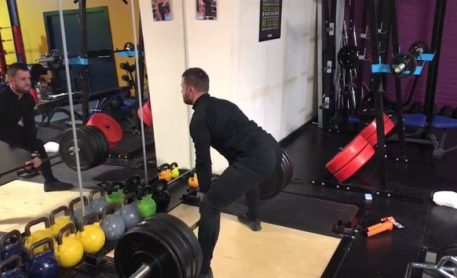
The Deadlift: The King of all Exercises, Part 2
Training Offered
- Join Today
- Our Personal Trainers
- Face To Face Personal Training Leeds
- Your First Session
- Online Training Leeds
- Remote Personal Training Leeds
- Ladies Kickboxing Leeds
- Under 18S Fitness Leeds
- School Programmes
- Corporate Team Events
- Gym Space Hire Leeds
- Salon Room To Rent Leeds
- Gym Access
- Covid-19 Rehabilitation
- Low Back Pain Treatment
- Boot Camps Leeds
- Food Intake & Nutrition
- Kickboxing Classes Leeds
- Personal Training Leeds Faqs
27
Nov
The Deadlift: The King of all Exercises, Part 2
By: Chris Loliva personaltrainingleeds, weighttraining, Deadlift

In the previous blog we discovered the benefits of the deadlift and why I consider it to be the king of all exercises.
In todays’ part I will be discussing the 3 key variations, the impacts on the body and a further 6 popular variations of mine.

Conventional
The conventional deadlift is the most common variation of them all. In order to perform this type of deadlift, you should approach the barbell with your feet shoulder width apart, bend down and push your hips back whilst keeping your back straight, grab the barbell with the distance of your hands shoulder width apart.
The barbell should be as close as possible to the body during the entire movement, then thinking about pushing the floor away from you as you lift the barbell.
The conventional stance targets your hamstrings, glutes and lower back. This focuses on building that posterior chain strength and endurance.

Sumo stance-
The sumo stance is a personal favourite of mine. In order to perform this style of deadlift you approach the barbell with your stance beyond your shoulders and your feet externally rotated outside. The wide stance will reflect squat position in comparison to the conventional stance. The position of the hands will always be shoulder width apart but this time due of the wide stance position your arms and hands will be inside your legs.
The sumo deadlift focuses on legs, upper whilst applying less stress on the lower back.

Trap Bar-
The Trap Bar is a variation of the deadlift. The Trap Bar is a weight training barbell made up of multiple bars that are bent into a hexagon shape in the middle. The hexagon shape is horizontal to the floor and large enough for a lifter to stand within. This variation is very beneficial for beginners or people with mobility restriction and many will be able to lift more
To perform this lift, you should step and stand inside the bar, bend down and grab the handles. With the trap bar deadlift you will have less stress during the lift on your lower back, this stress will be directed to the legs (in particular the quads), upper back, traps, shoulder and last but not least your grip will improve like never before.
In addition to the above I have taken the time to outline a further 6 variations of the deadlift, some of personal favourites guaranteed to get the legs burning!
The Rack Pull
The rack pull is lift very similar to the conventional deadlift with the exception you will position the barbell in a rack. The barbell should be positioned slightly below knee height, from there you going to have the same set up of conventional deadlift. This places less stress on hamstring and lower back and increases the amount of the weight lifted.
The Deficit Deadlift
The deficit means to position yourself higher than floor level, you can perform this with sumo stance, conventional or trap bar deadlift. The purpose of the deficit is to increase the strength of the lower back, for those who struggle to separate the barbell from the floor, or for those who want to increase the range of motion as this method will increase the distance the barbell needs to travel from the floor resulting in more time under tension.
Snatch Grip Deadlift
The Snatch grip deadlift (my absolutely favourite in pair with deficit), like the name suggests the setup is the same as a conventional deadlift with the exception that you will practice a snatch grip. The snatch grip is much wider than shoulder width and your thumb is positioned under your fingers. This variation will drastically destroy and improve your grip strength and trap development.
Single Leg Deadlift
The single leg deadlift can be performed in a different way using a dumbbell, kettlebell or barbell. This variation starts just like the conventional method lifting one of your feet from the floor behind you. From there you can position the weight on the side of your body or in front of you and lift with one hand or both. This variation is great to work if you have got any imbalance and coordination issues which need developing.
Paused Deadlift
You can perform the paused deadlift with any of the 3 key variations already mentioned. As the name suggests, after you lift the weight from the floor you pause the lift just below the knee for 1 or 2 second before completing the lift and returning to ground position. The pause help strengthen the lower back and the posterior chain of your body.
Banded Deadlift
This is another great variation that helps develop the lifters explosive power. In order to perform this variation we attach the resistance band between two anchors on either side of the barbell or trap bar and place the band over each end. The technique to the lift stays the same but the last part of the lift results in an increase in resistance.
Thanks for reading my blog, I hope you found it useful. If you’d like any further information or advice about training please feel free to get in touch and email me on [email protected]
Keep visiting Elemental Fitness blogs for nutritional, training tips and advice 😊


